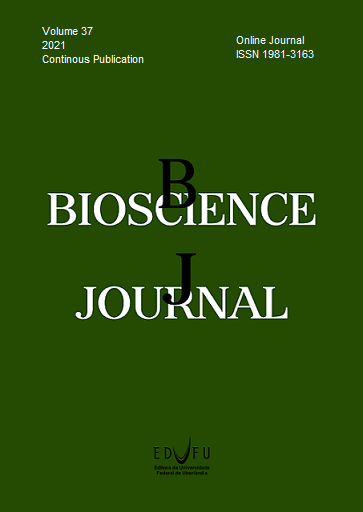Evaluation of the scientific activity of the leaf of the species Campomanesia pubescens in wound model infected by Staphylococcus aureus
DOI:
https://doi.org/10.14393/BJ-v37n0a2021-42182Keywords:
Healing, Herbal Medicines, Rats, Wound Infection.Abstract
There is an increasing interest in the use of herbal remedies as healing agents, due to their lower cost in relation to other drugs and the vast Brazilian fauna. The objective of this research was to evaluate the cicatrization effect of the guariroba leaf (Campomanesia pubescens) on the healing of infected wounds. We used 45 Wistar rats, distributed in five groups (n = 9) all with surgically induced skin injury, differing in the presence of contamination and treatment, with evaluation periods of 3, 7 and 14 days, being: G1- negative control without contamination, treated with Physiological Solution 0.9%; G2- control with contamination, treated with Physiological Solution 0.9%; G3 negative with contamination, treated with Carbopol in 0.5% gel; G4- positive control with contamination, treated with Colagenase at 0.6 U / g + 0.01 g Chloramphenicol; G5- positive test with contamination treated with Campomanesia pubescens at 3%, whose vehicle was Carbopol at 0.5%. The wound was made with a metal punch 8 mm in diameter, and a cutaneous fragment was removed from the animals' backs and wound infection was applied to S. aureus in groups G2 to G5. Euthanasia was performed for a lethal dose of anesthetic, and the edges of the wounds were removed for histopathological study. The fibrinoleukocytic crust was present in all animals in the groups of 3, 7 and 14 days. The contraction of the wound was also evaluated, and all groups showed low percentage of wound regression in the 3-day treatment and with 14 days presented a high percentage of regression. Of the 5 groups, the only one that presented complete epithelialization was G5. Of the 5 groups, the ones with the best epithelialization were G4 and G5. The group with the highest amount of mature collagen fibers was G4, followed by G5, and the one with the highest proportion of immature fibers was G1. At the end of the experiment, G4 was the group that gained the most weight and G1 the one that had the lowest weight gain. Guariroba leaf extract (Campomanesia pubescens) was able to promote healing in infected skin wounds similar to the group treated with antibiotics.
References
BEDOYA, S.A.O., et al. Caracterização de colágenos tipos I e III no estroma do carcinoma de células escamosas cutâneo em cães. Arquivo Brasileiro Medicina Veterinária e Zootecnia. 2016, 68(1), 147-154. http://dx.doi.org/10.1590/1678-4162-8484
BRASIL. Ministério da Saúde. Secretaria de Atenção à Saúde. Departamento de Atenção Básica. Política nacional de práticas integrativas e complementares no SUS: atitude de ampliação de acesso. 2. ed. Brasília: Ministério da Saúde, 2015. Available from: http://bvsms.saude.gov.br/bvs/publicacoes/pnpic.pdf
CAMPOS, A.C.L., et al. Cicatrização de feridas. ABCD, Arquivos Brasileiros de Cirurgia Digestiva. 2007, 20(1), 51-58. https://doi.org/10.1590/S0102-67202007000100010
CARDOSO, C.A., et al. Antimicrobial activity of the extracts and fractions of hexanic fruits of Campomanesia species (Myrtaceae). Journal of Medicinal Food. 2010, 13(5), 1273-1276. https://doi.org/10.1089/jmf.2009.0047
CARDOSO, C.A.L., SALVADOR, M.J., CARVALHO, J.E and CARVALHO, R.G. Avaliação das atividades antiproliferativa e antioxidante em frutos de Campomanesia pubescens. Revista do Instituto Adolfo Lutz. 2013, 72(4), 309-315.
CARMIGNAN, F., et al. Efficacy of application of Equisetum pyramidale Goldm. hydrogel for tissue restoration of induced skin lesions in Wistar rats. Brazilian Journal of Biology. 2020, 80(1), 12-22. https://doi.org/10.1590/1519-6984.184409
CHANG, R., et al. Essential Oil Composition and Antioxidant and Antimicrobial Properties of Campomanesia pubescens O. Berg, Native of Brazilian Cerrado. Latin American Journal of Pharmacy. 2011, 30(9), 1843-8. https://doi.org/10.1089=jmf.2009.0047
CORRÊA, A.C.L., et al. Healing effect of the ointment made of Equisetum pyramidale in the treatment of cutaneous lesions in diabetic rats. Brazilian Archives of Biology and Technology. 2013, 56(3), 377-382. https://doi.org/10.1590/S1516-89132013000300005
COSTA, L.D., et al., Identificação dos colágenos I, III, IV e α-SMA e participação dos miofibroblastos no processo fibrótico das endometroses equinas. Arquivo Brasileiro de Medicina Veterinária e Zootecnia. 2017, 69(6), 1398-1406. https://doi.org/10.1590/1678-4162-9273
CRUZ, A.V.M. and KAPLAN, M.A.C. Uso medicinal de espécies das famílias Myrtaceae e Melastomataceae no Brasil. Floresta Ambiente. 2004, 11(1), 47–52.
GOLDIM, R.M.F. Avaliação da cicatrização cutânea: fluorescência e estereologia. 2012. Tese (Doutorado em Ciências) – Faculdade de Medicina da Universidade de São Paulo. 2012.
HADDAD, M.C.L., et al. Influência do açúcar no processo de cicatrização de incisões cirúrgicas infectadas. Revista Latino-Americana de Enfermagem. 2000, 8(1), 57-65. http://dx.doi.org/10.1590/S0104-11692000000100009
HAMINIUK, C.W.I., et al. Chemical, antioxidant and antibacterial study of Brazilian fruits. International Journal of Food Science and Technology. 2011, 46, 1529 – 1537. https://doi.org/10.1111/j.1365-2621.2011.02653.x
LEMOS, M.C. Comparação entre histologia e espectroscopia de fluorescência para avaliação de atrofia cutânea induzida por glicocorticóide em ratos. Dissertação (Mestrado em Biotecnologia) – Universidade Federal de São Carlos. 2011.
MULLER, J.A.I., et al. The effect of Sebastiania hispida gel on wound model infected by methicillin resistant Staphylococcus aureus. Biomedicine & Pharmacotherapy. 2018, 105, 1311-1317. https://doi.org/10.1016/j.biopha.2018.06.100
RAMOS, D.D., et al. Avaliação do potencial citotóxico e atividade antioxidante em Campomanesia adamantium (Cambess.) O. Berg (Myrtaceae). Revista Brasileira de Biociências. 2007, 5(2), 774-776.
RIBEIRO, F.A.Q., et al. Análise da concentração de colágeno tipo I e III presente no reparo de feridas tratadas com Mitomicina C em ratos. Arquivos Médicos e dos Hospitais e da Faculdade de Ciências Médicas da Santa Casa São Paulo. 2015, 60(1), 22-26.
TAZIMA, M.F.G.S., et al. Biologia da ferida e cicatrização. Medicina (Ribeirão Preto. Online). 2008, 41(3), 259-264.
VILLAS BOAS, G.R., et al. Preclinical safety evaluation of the ethanolic extract from guavira fruits (Campomanesia pubescens (D.C.) O. BERG) in experimental models of acute and short-term toxicity in rats. Food and Chemical Toxicology. 2018, 118, 1-12. https://doi.org/10.1016/j.fct.2018.04.063
Downloads
Published
Issue
Section
License
Copyright (c) 2021 Larissa Chaves Pradella, Doroty Mesquita Dourado, Carlos Henrique Marques dos Santos, Maria Helena Fermiano, Rosemary Matias, Baldomero Antonio Kato da Silva

This work is licensed under a Creative Commons Attribution 4.0 International License.





